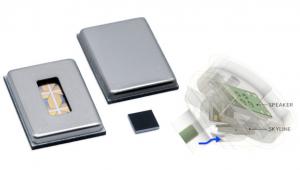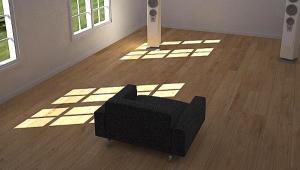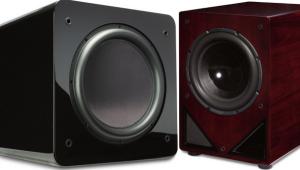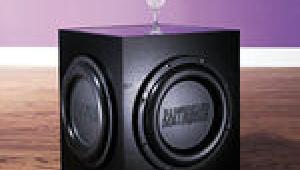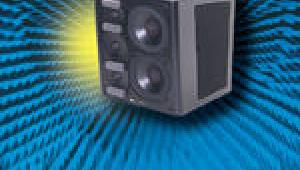Ed Mullen, Director of Technology and Customer Relations, SVS
 Ed Mullen so impressed everyone with his subwoofer smarts (and even temperament) as a participant on Internet audio forums that SVS—a company that has mostly specialized in subwoofers, but is now putting equal effort into speakers—hired him. He now enjoys a rep among home theater enthusiasts as one of the guys to call for advice about subs. Excerpts from this interview appear in the feature story “Subwoofers: The Guts and the Glory.”
Ed Mullen so impressed everyone with his subwoofer smarts (and even temperament) as a participant on Internet audio forums that SVS—a company that has mostly specialized in subwoofers, but is now putting equal effort into speakers—hired him. He now enjoys a rep among home theater enthusiasts as one of the guys to call for advice about subs. Excerpts from this interview appear in the feature story “Subwoofers: The Guts and the Glory.”
S&V: What’s the most important aspect of a subwoofer: the driver, the enclosure, or the amplifier?
EM: SVS takes a holistic approach to sub design. It’s very possible to use high-quality components that don’t work well together, and the results will not be optimal. We look at the end-user application, then develop a list of components for that application. You’ve got to match enclosure size, the form factor, the amplifier power, and the driver itself. Use of quality components is a given with our subs, but they also have to be well-matched and work together synergistically.
So they’re all equally important. You have to look at it as a system, because there’s so much involved. A sub needs to have flat response, low distortion, good bandwidth linearity—that means good output in both octaves [20 to 40 Hz and 40 to 80 Hz]—and good behavior when it reaches its limits, i.e., not bottoming, shutting itself off, or distorting badly.
The room is the last part of equation. A small room has a lot of room gain. Depending on the sub, it might sound good with the room gain, or it might sound bloated.
S&V: Do you have a preference for ported, sealed, or passive radiator subwoofers? How do the design decisions differ among those three?
EM: We offer two basic designs: compact sealed and large ported. In a small to mid-size rooms, we typically envision a mixed-media application. That customer is looking for a sub that is not visually intrusive, sounds great, and can achieve a moderately loud playback level. The fact that a smaller sub has less output in the deepest octave than our larger models may not even manifest itself, because the customer may not even be pushing the sub hard enough to hear that.
With a sealed sub, maximum output in the deepest octave is not necessarily a top priority. The shallower roll-off of the sealed sub [typically 12 dB/octave, versus 24 to 36 dB/octave for a ported sub] can work better in a small to mid-size room due to room gain. Whereas a larger ported sub may not be a good match for the room gain and could sound bottom-heavy.
There’s no substitute for cubic inches. The larger enclosures have much higher efficiency and output at the lowest frequencies. Bass reflex [ported] alignment has much higher maximum output than a smaller sealed sub at the same price point. Typically it’s the hardcore action/fantasy Blu-ray fan that wants to play the system at or near reference level, and that kind of person may lean toward the ported sub.
S&V: So ported for home theater, sealed for music?
EM: If you push the port tuning really deep, bass reflex can sound very good on music because the group delay is shifted down below the music bandwidth. A sealed sub generally has a bit of an edge for music lovers due to the lower overall group delay and superior time domain behavior.
If you look at a sub like the SB13-Ultra [the company’s largest sealed-box subwoofer], the phase response is quite benign, the roll-off slope is shallower, and there’s less phase rotation below the –3 dB point so there’s less group delay. Subjectively you get that stop-on-a-dime bass that enthusiasts describe as faster or tighter. We specifically designed the SB13-Ultra to have optimum group delay and time domain behavior. That doesn’t mean our bass-reflex subs are bad for music, because we do everything we can to maximize frequency response and bandwidth linearity [equality of maximum output at all frequencies], and to shift the phase rotation below the music bandwidth. With that said, if you plot the group delay and look at time domain behavior, you will see distinct ringing near the port tuning as compared to the sealed box.
S&V: How do you feel about minisubs, the small subwoofers that use high-excursion drivers and high-powered amps to get deep extension and high output. Can a minisub equal the performance of a conventional, larger sub?
EM: That type of brute force design typically has a lot of compromises. You need a real heavy-duty driver, with a big voice coil with high thermal capacity because you’re dumping thousands of watts into it. The moving mass of the driver is typically high and the enclosure is small, so system sensitivity suffers. That requires a massive amp, which is very expensive. There’s also a lot of heat generated inside the enclosure, even if it’s a Class D amp. If you add passive radiators, in order to tune them to a sufficiently deep frequency, you have to add a lot of weight because the enclosure is so small, so low-frequency efficiency suffers. The whole thing is just a bunch of compromises designed to overcome laws of physics. Typically it doesn’t sound that good from an accuracy or transient response standpoint, especially on music. Distortion at low frequencies is often quite high, mainly because of the passive radiators. If you push them hard, to high excursion levels, they start to exhibit non-linear behavior.
We prefer to accept the laws of physics, and don’t try to force a sub to be something it’s not, which is why we favor a straight sealed design with an optimized roll-off profile for our more compact subs.
S&V: What kinds of measurements do you do to evaluate a subwoofer design?
EM: We do long-term maximum output, CEA-2010, frequency response, phase response and time domain behavior. If you get the frequency response wrong, it’s never going to sound right. It’s hard to say one frequency response fits all applications, though, because it doesn’t. We want the frequency response to be optimized for the intended application.
"If you get the frequency response wrong, it’s never going to sound right. It’s hard to say one frequency response fits all applications, though, because it doesn’t."
Another thing that we focus on heavily is the subwoofer behavior at the performance limits. We have found some of the other brands don’t focus as much on that. If you push the sub too hard, what does it do when it’s overdriven? Does the woofer bottom, do you get port noise, does the amp clip? Nothing takes you out of the experience faster than a sub that’s puking. When you overdrive an SVS sub, it’s not going to make grossly obvious sonic artifacts.We do a lot of work with our limiter/compressor algorithms to make sure the sub sounds clean at all frequencies and levels. Our limiter/compressor algorithms are frequency-dependent. At higher frequencies, the output of our subs is usually limited by the amplifier; the amp runs out of steam before the driver does, and we’ll be under the CEA-2010 distortion thresholds when the limiter kicks in. At lower frequencies, the mechanical limits of the driver become more of an issue. The question then becomes, how much further can you push the sub? How much more output can we extract past the CEA-2010 limits—maybe 1 or 2 dB? Beyond that and the system quickly goes non-linear. There’s usually not a lot left in the tank after CEA-2010 limit is reached, so typically what we’ll do is draw the line dynamically just a little past the CEA-2010 limits at lowest frequencies.
S&V: Could you explain what you mean when you talk about the thermal limits of the driver?
EM: A sub driver has two basic forms of limitation: mechanical and thermal. The mechanical limits— the maximum the cone can move forward or backward without becoming non-linear—typically only come into play at lower frequencies, because at higher frequencies the cone isn’t moving that much even when the system is playing really loud. The thermal limit has to do with the speaker’s voice coil; if you exceed the thermal limits you’ll see power compression or possibly even smoke the coil. That’s why if we’re using, say, a 400-watt amp, we’ll typically use a coil rated for more to avoid power compression or thermal failures.
S&V: How has the advent of cheap digital signal processing (DSP) chips changed your designs? And what goals do you set when you tune the digital signal processors on your subwoofers? Do you make the response flat, or do you put in bumps in the response to give the sub a certain sound?
EM: DSP has been a huge advance for SVS. Dealing with analog boards was arduous and tedious to say the least. If you look at the native frequency response of a sub, it’s generally anything but flat, so you need to EQ it in the amplifier to get it right.
DSP allows us to easily implement very a precise EQ function, so we can hit our target corner [–3 dB] frequency, low-frequency roll-off slope, and overall frequency response. DSP also allows us to maximize the performance of our subs at the limits, because with DSP the compressor algorithms can be quite complex. We can change values on the fly, reevaluate the change in acoustic performance, and really dial it in.
Then when we get to 95 percent, we do a long and detailed listening session. We listen at moderate, loud, and abusive levels. We’re always going for a flat frequency response above the corner frequency. Having all those jazz, rock, and movie modes in a subwoofer menu is silly. Flat response is most accurate and gives the least coloration. Why would a design deliberately deviate from the input signal, so that different frequencies are over- or underrepresented in some way?
S&V: Do you have a certain Q [resonance bandwidth] that you prefer?
EM: This is driving at whether the system is under-damped, over-damped, or maximally flat. The SB13-Ultra response is slightly overdamped—meaning low-Q—with a tighter sound quality. This gives it a broad, gradual transition from flat to the roll-off at the lowest frequencies. The benefit here is sound quality, because group delay and impulse response and time domain ringing are superior with low-Q alignments. Let’s say we change the system to under-damped. Sure, it will have a bit more output at the corner or knee, but it will also sound more loose and rubbery, so we don’t go there.
On our ported subs that offer foam port plugs so you can alter the system tuning, we shoot for a maximally flat frequency response with all ports open and a slightly over-damped alignment if a port is plugged. This gives you a better in-room response when room gain is factored in, and gets close to maximally flat in-room.
S&V: How do you feel about the automatic EQ/room correction technologies that are built into receivers and pre/pros?
EM: As good as auto setup is, they still make non-optimal choices, sometimes even outright mistakes. Sometimes we see it set a small in-wall or in-ceiling speaker to large/full-range. Seems impossible but it does happen. Most auto setup systems do well at time alignment, level,and EQ, but where they make the most mistakes is digital bass management. They’ll set speakers to either large/full-range or a too-deep crossover frequency. I think it’s because these systems run their test tones at a relatively low level. Maybe the speaker has usable response to fairly deep frequencies at lower drive levels, but then falls apart dynamically down low when pushed hard. This is why we always encourage our customers to call us and we’ll help them optimize the whole set-up.
"Most auto setup systems do well at time alignment, level, and EQ, but where they make the most mistakes is digital bass management."
S&V: So how do you usually suggest they set the crossover in the receiver?EM: A good rule of thumb for a digital crossover is to take the rated deep extension of the speaker and bump it up 10 to 20 Hz. With typical crossover frequencies in the 60 to 100 Hz range, the bass is still somewhat directional, so subwoofer placement does matter. A subwoofer doesn’t become truly non-directional until the crossover is down around 40 Hz. That’s one reason we usually recommend placing the subwoofer in the front of the room, so it blends well with the front and center speakers.
S&V: Any other recommendations on subwoofer placement you’d like to share?
EM: Corner placement excites all possible room modes. The more modes you’re exciting, the less potential there is for a gaping hole in the frequency response—i.e., a null. To the extent corner placement creates peaks in the response, they can be fixed by auto setup, if the auto setup EQs the sub channel. If you look at Audyssey MultEQ XT32, it has hundreds of correction points in the subwoofer channel, so you can shoot for corner placement, excite all modes, minimize the potential for nulls and let XT32 kill the peaks.
If auto setup doesn’t EQ the subwoofer, then placement becomes more critical and we encourage experimentation with all possible sub locations and/or performing the subwoofer crawl. There are certainly times where non-corner placement works out the best, especially when the auto setup doesn’t EQ the sub.
S&V: Would you recommend S&V readers buy four smaller subs, two midsized subs, or one large sub, if the price for the different packages were about the same?
EM: It’s very common for customers to have room for only one subwoofer. If that’s the case, then we try to size the single subwoofer to the playback level and performance requirements for that application.
We’re big proponents of dual subs. If you don’t have a spot where a single sub sounds good, then using two subs can really smooth the frequency response in the room and make the subs harder to localize. Dual discrete stereo subs are also great in two-channel rigs.
A sub in all four corners certainly maximizes modal density and is the ultimate solution, but it’s often a non-starter even in dedicated theaters.
Overall playback level is a factor, too. In addition to increasing modal density, multiple subs also add overall headroom. So we ask customers to tell us what they’re using the system for: music, gaming, movies, casual background use? How much slam and impact do they want on action movies or gaming? We’ll get the hardcore movie fans who want to reproduce THX/IMAX levels in a large home theater, and we’ll steer them into highest-output solutions we offer, like multiple ported subs. On the other hand, many customers want great sound quality and smooth bass in all the seats, but aren’t looking to tear down the walls, so we might steer them into a pair of smaller sealed subs.
S&V: Any recommendations on how to incorporate a subwoofer into a two-channel system, since almost no two-channel preamps or integrated amps have subwoofer crossovers built in?
EM: We are huge fans of stereo subs for two-channel systems. Take a given two-channel system and try running one sub, then try two subs but both with the same signal. And then try true stereo subs. Discrete stereo subs will win the comparison every time. There are directional bass cues in many recordings. Yes, they come from the main speakers, but they also come from the subs depending on where the subs are low-passed. Typically we try to get the subs as close to the speakers as possible so they’re all time-aligned, since most two-channel pre/pros lack a time-alignment feature.
To hook it up, run the same line-level signal to the subs as to your main amp. Run a full-range signal to the sub and adjust the volume and crossover frequency so it blends with the natural sensitivity and low frequency roll-off of the main speakers. I am not a fan of high-passing the main speakers. I think a speaker sounds best when it rolls off naturally. Plus a lot of main speakers are ported and are already rolling off at 24 dB/octave below tuning, so why would you add more to that? The end goal should be that the system sounds like you have full-range tower speakers and not separate speakers and subs.
S&V: Don’t you get lower distortion by high-passing the main speakers so they don’t have to reproduce deep bass?
EM: In a typical two-channel system, the user simply isn’t pushing the system to its limits, even with bookshelf speakers. And most of the time it’s a pretty high-quality bookshelf. For example, with enough clean power our Ultra bookshelf can play obscenely loud before it reaches its limits. So again, why high-pass it? Let it roll off naturally and blend in with the subs.
- Log in or register to post comments
